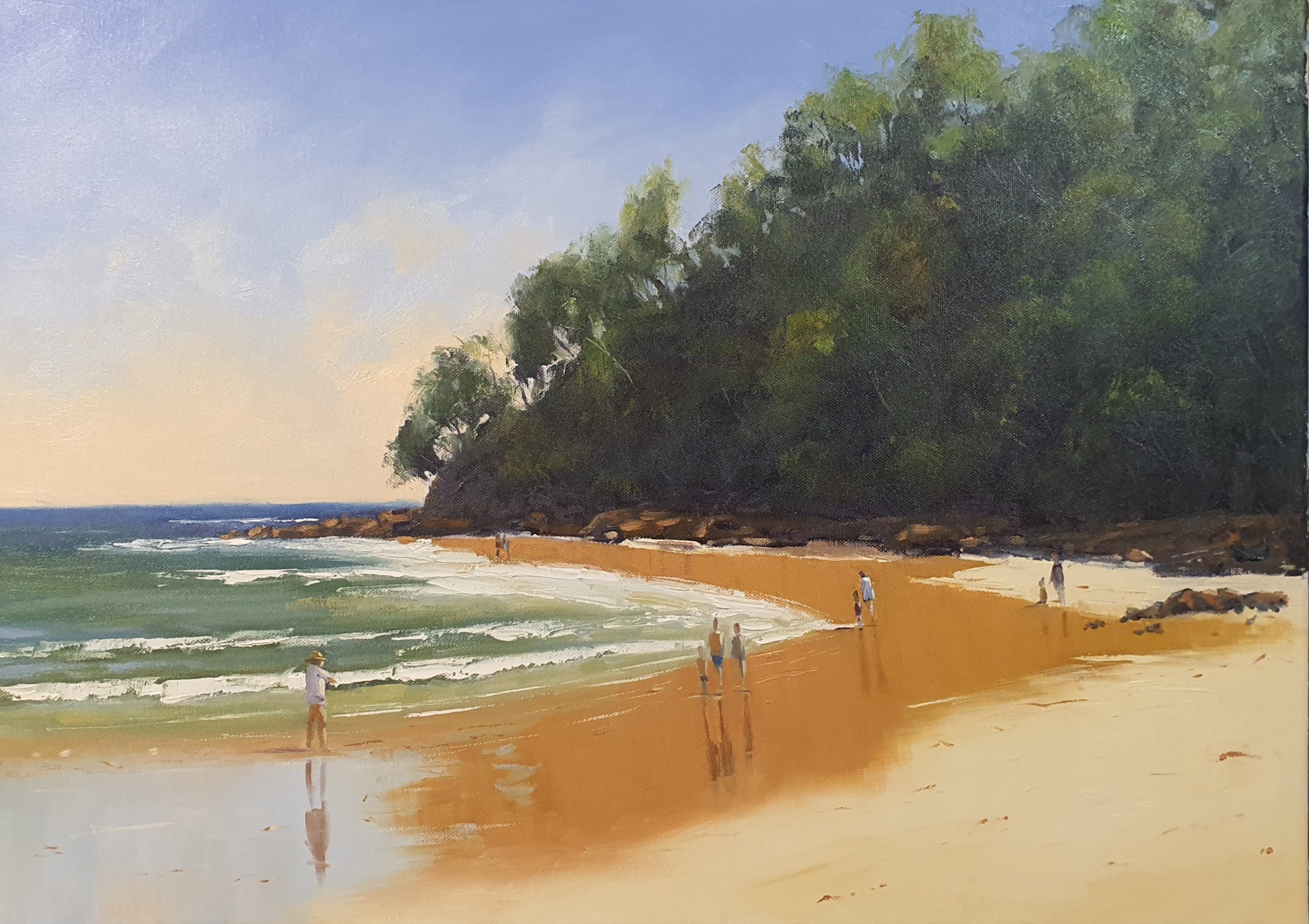
Painting Process Step By Step – Part 2
December 1, 2020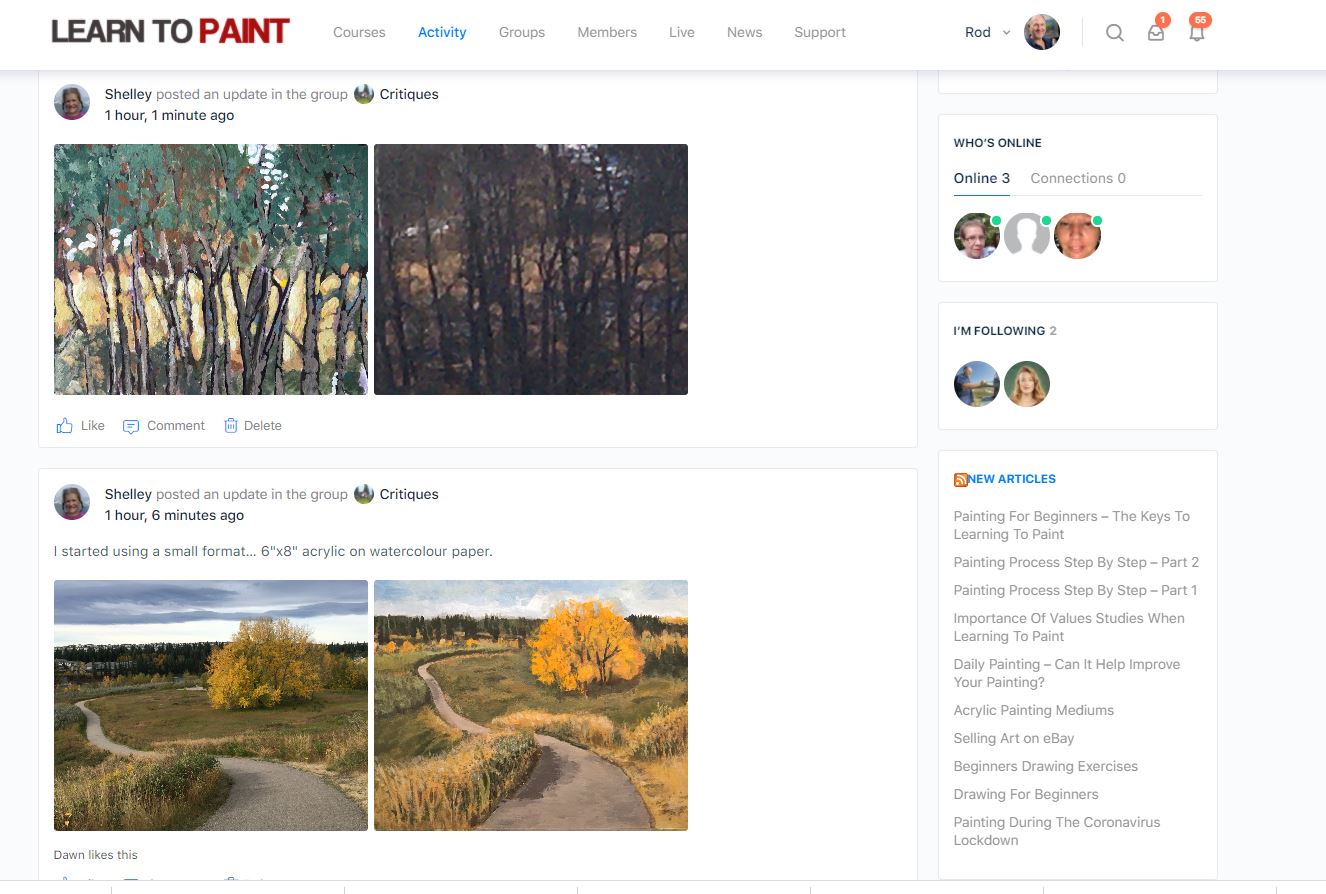
Important Updates To Members Area
December 23, 2020Learning to paint is a journey. Starting painting for beginners is the start of a journey that might last a lifetime.
At times painting for beginners is frustrating and difficult, and at times joyful and exhilarating. It is a journey on which you experience a full spectrum of emotions and highs and lows.
Once it gets in your blood though its a journey we can’t help but take.
In this article I want to explore with you the keys that will help you improve your paintings as a beginner and enjoy the journey even more. And if you have a particular destination in mind for your journey then these keys will help you arrive there faster.
Before we dive into it though I want to address one important point:
Painting For Beginners vs The Myth of Natural Born Talent
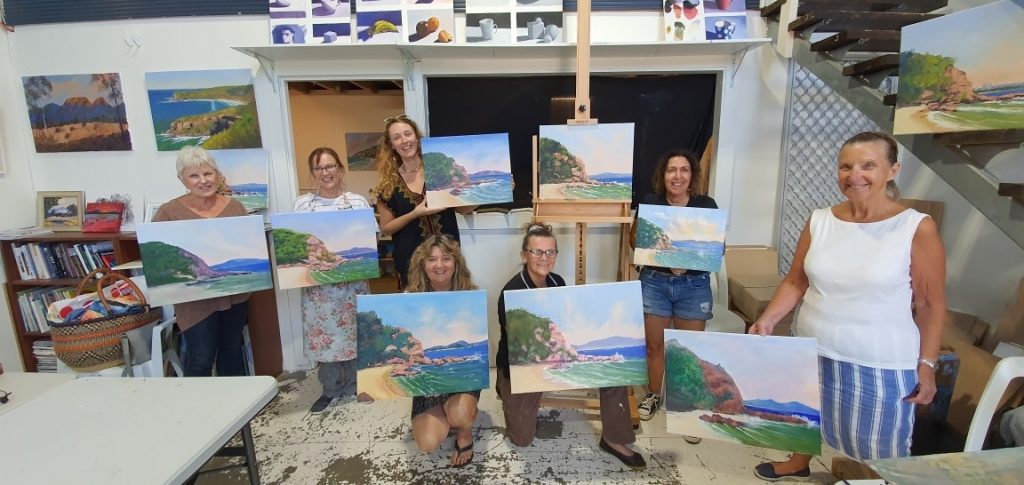
In the moments when our painting is frustrating the life out of us and nothing is going right it is easy to make the assumption that you just don’t have any talent.
I remember the excitement I felt when I first purchased a range of paints, brushes, and canvases and took it all home to try my very first painting. With no knowledge or skill and fueled with pure optimism I set up in the back yard on the weekend and did my very first painting.
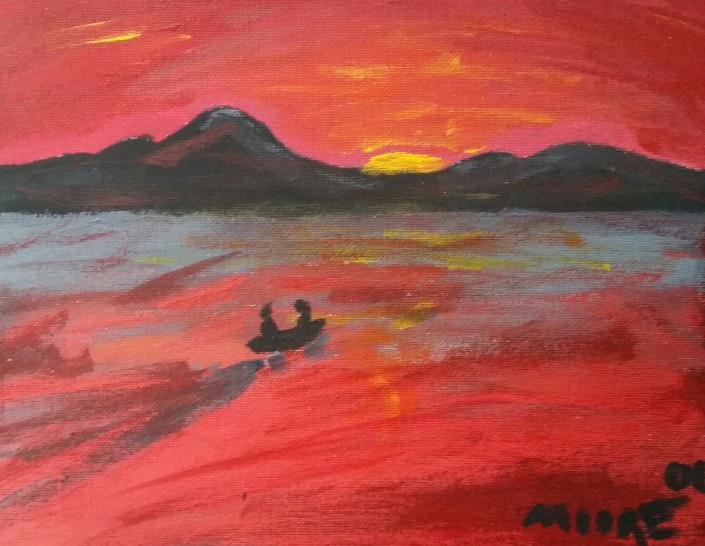
My optimism soon turned to despair as it did not measure up to the master work I had imagined myself doing. I realized that painting for beginners was a challenge 🙂
So I did what many beginners do at such a point … I concluded that I must not have been born with any talent. With that I packed everything in a box and the box went under the bed not to be looked at again for some years.
I’m not sure if you have had a similar experience or not?
What I have come to learn in the last ten years, as I worked to become a professional artist, is this … learning to paint and developing a high level of proficiency with paint has nothing to do with natural talent.
Don’t get me wrong! I do believe natural talent does exist. However it is so rare that it is not even worth considering or focusing on.
For the 99.9% of us not born naturally talented we have to take a different approach to becoming great artists.
What is the path for the majority of us then?
It’s a two part process.
First we have to learn the technical aspects of good painting.
Second we have to combine these technical aspects with the intangible quality of artistry.
It is possible to become a highly successful artist just by mastering the technical aspects of good painting. Many have done so before you and many more will in the future.
What Are The Technical Aspects of Painting?
A good question then is what are these technical aspects of painting that we need to master?
The good news is there are only a few. We call them fundamentals. The basics.
The less good news is that mastering these fundamentals can take years, decades or a lifetime. As I said at the start of this article … it’s a journey.
Sidenote – Each of us endeavouring to become great artists are on a unique and personal journey. We all have different starting points, life circumstances, committment and dedication, focus, ability to comprehend information and destination points in mind. Your journey is unique to you and as such you should never compare yourself and your journey to anyone else.
So the technical aspects of painting, or fundamentals, include the following:
- Concept
- Drawing
- Composition & Design
- Values
- Colour
- Edges
- Brushwork
- Process
- Self Analysis
At the Learn To Paint Academy we have developed a range of courses that address each of these fundamental skill sets.
To become a really great artist you need to focus on each of these fundamental skills. It is a good idea to set aside time to study each of these fundamentals and complete various assignments or studies designed to develop your skills. In the same way a concert pianist will practice scales for hours a day, we need to spend more time studying the basics rather than always trying to paint a master piece.
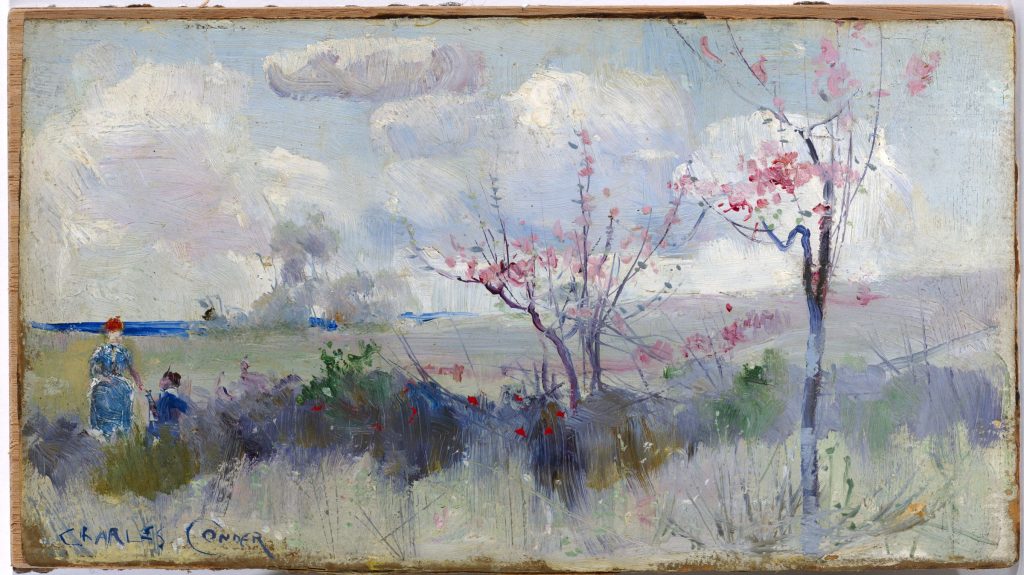
by Charles Conder
Understanding The Learning Process
Learning anything, especially painting for beginners, requires two things:
1/ Knowledge
2/ Practical application of that knowledge
Learning to paint is no different.
You need to decide how much time you will set aside for painting each week. Then divide that time between firstly gaining knowledge through study of these fundamentals (or technical aspects), and secondly practicing what you have learned.
Both of these are critical if you are to advance.
You need knowledge and you need to practice that knowledge. We have designed the Learn To Paint Academy with this in mind … courses to give you the knowledge, and lots of painting projects for you to practice the knowledge you have acquired.
As we focus on gaining knowledge of the fundamentals, and putting this knowledge into practice, we need to keep in mind the following …
Four Stages Of Learning Anything
by Rod Moore
There are four stages of learning anything. When you are familiar with them it will help you get a clear understanding of where you are on your journey and how to keep moving forward.
These four stages apply to everything … learning to paint, playing golf, programming computers, driving a car, cooking great vegan meals and so on.
We all move through these four stages:
1/ Unconscious Incompetent – When we first try to learn something new we are unconsciously incompetent. What this means is we know nothing about what needs to happen to become a great painter, but even worse, we don’t know what we don’t know. A lot of the keys to becoming a good painter we have never even heard of when we are starting out. Ideas like Notan studies, compressed values, high key painting, lost edges mean nothing to us and likely we have never even heard of them let alone understand them. We all start here … knowing nothing and not even being aware of what we don’t know
2/ Consciously Incompetent – this stage usually is when we first start painting. We perhaps watch some YouTube vides, do an online course, read a book etc. So we buy some art supplies and have a go. And typically we start to realize how little we know and how lacking our skills are. We become conscious of the fact we are incompetent with the basic skills. This is the frustration period. This is when so many assume they don’t have talent for painting and quit. Don’t do that. Push on. In this stage we start to develop some conscious awareness of different fundamentals like colour mixing etc but we are still incompetent in our application of this knowledge.
3/ Consciously Competent – in this stage we have gained some knowledge through study, and we have some skills in applying that knowledge. We are consciously aware of the fundamentals and probably have a good degree of knowledge stored away about them, and we are starting to get good at applying it. At this stage we are producing reasonable quality paintings. Often we see artists start to sell a few pieces, enter the local art show and so on when they reach this stage.
Note – Interestingly I believe this third stage is the longest stage and its easy to get stuck here. We have a high level of skill and competency in applying the fundamentals … but we are often stuck in our thoughts.
4/ Unconscious Competence – This is the level of mastery. In this stage you no longer need to think when you paint. If you need to mix an earthy warm brown tone for rocks in sunlight you don’t need to consciously think through how to do this. It becomes automatic. Your skills in practical application have shifted to the unconscious mind. As a result you free yourself up and this opens a door way to a higher level of artistry to enter. When you stop thinking about what you are doing you step into a state of flow which enables you to tap into a level or creativity that is from a different source.
When you reach this fourth stage you are a true master of painting. People will comment how you make it look so easy.
And while it may be easy at this last stage the journey to get there certainly is not. It takes time and dedication to arrive at stage four if that is your goal.
It is my belief that practically anyone can reach this fourth stage given sufficient focus, dedication and committment and the passage of time. Reaching this level though becomes more about mindset than anything else.
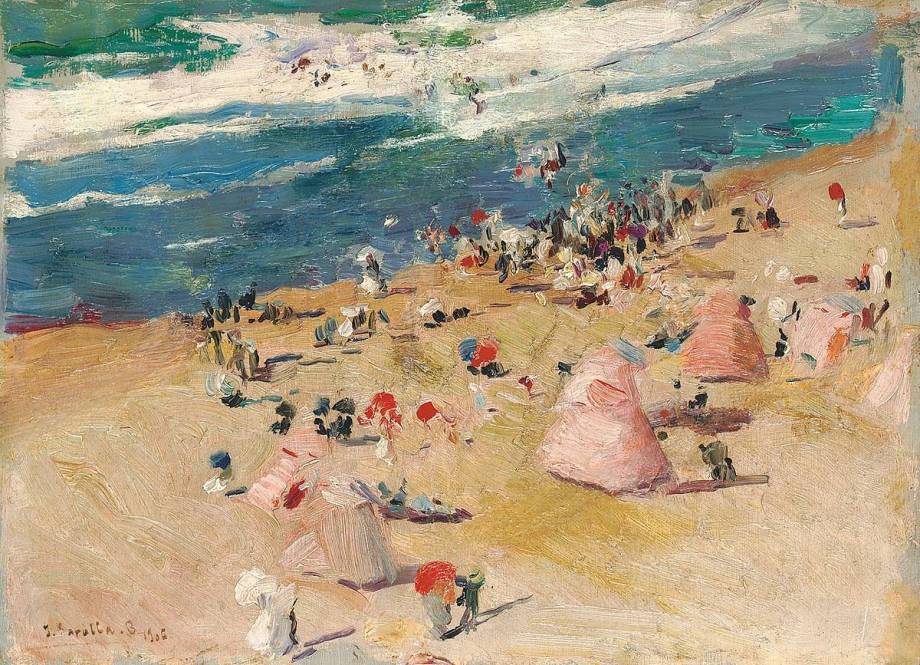
Joaquin Sorolla
At the very least we should all aim for stage three.
Understanding these four stages of learning will hopefully help you to stick with painting when nothing seems to be working, your turning out paintings your not happy with, and you become frustrated. Trust me we all go through this. As you move into stage three though the times of frustration are less however you also realize how much more there is to learn 🙂
Before You Start Painting
Before you make a start on your painting journey as a beginner its a good idea to get clear on a few things up front.
Some of the questions you may want to consider are below. A good practice is to start a journal and write your answers in the journal. You can then reflect on your answers over time, and even up date your responses to these questions.
Your answers to these questions will serve as your true north, your guiding star on your journey.
As mentioned earlier, we are all on totally unique and individual journeys when it comes to developing our painting skills.
Side note – There are no right or wrong answers to these questions. Only what is right for you.
Here are the questions to ask yourself:
- Why do you want to learn to paint?
- What is the inspiration behind wanting to learn to paint?
- What draws you to a piece of artwork?
- What turns you off a piece of artwork?
- List half a dozen artists whose work moves you emotionally
- What is it about these artists and their work that moves you?
- What subject matter are you inspired to paint? Why?
- Which medium do you feel you can best express yourself in? Acrylics, Oils, Gouache, Watercolour, Pencil, Charcoal
- What do you want to say with your art?
- What message if any do you want to convey through your art?
- What impact do you want to have with your art?
- How much time will you make available each week for your art?
- When it comes to your art what do you want to be known for?
- How do you want people to feel when they see your art?
- Which artists do you most want to be compared to?
- What style of painting do you most want to explore?
- What obstacles, challenges and roadblocks do you see getting in your way?
- How can you deal with these?
- What goals or aspirations do you have for your art?
These are important questions to consider if you are serious about developing your skills with painting.
You don’t need to find answers to these all at once. It’s a process and the further along your journey you get the more clarity you will find with the answers to these questions.
Which Medium Will You Learn In?
An important consideration early on is which medium will you learn to paint with.
We will talk about focus later but for now I want to point out that it is better to stick with one medium and really develop your skills with it rather than jumping around from one to the other.
Note – At the Learn To Paint Academy the painting process we teach is the Moore Method of Painting. The beauty of this method is it is transferable from acrylics to oil painting, to water mixable oil paints, and to gouache. Once you learn the method you can pretty much transfer to any of these mediums with little effort.
The more common mediums to learn in are:
Acrylic – Acrylic paints are the most popular with beginners and hobby artists. Primarily because they are water based and low toxicity. They are also easy to clean up. The thing to note about acrylics is that they dry faster than oils and tend to shift in tone when dried. This can lead to frustration when you are starting out, but can also be a big advantage when you gain more experience.
Oils – Oils tend to be the preferred medium for professional artists. They also attract higher prices for sold artwork than other mediums so they are clearly regarded as more desirable by collectors. Oils have many advantages and they stay wet longer giving you more time to work back into them. This allows for multiple painting sessions working wet into wet paint. A lot of people stay away from oils due to the more toxic nature of the solvents, and the odor associated with them. Today you can buy non toxic low odor solvents and mediums to overcome this issue. There is a perception that oils are more difficult to master.
Water Mixable Oils – A great option which is a relatively new development is Water Mixable Oils. These are very close in nature to traditional oils but have the advantage that they can be washed up in water and water can be used as a thinner for initial washes. Low toxicity and low odor but they paint like oils makes this an increasingly popular option for many.
Gouache – Gouache is a water based medium that is opaque in nature. Traditionally used by illustrators, it is a versatile and portable medium that doesn’t take a lot of practice to get the hang of. As its water based you can thin it down with water. It dries rapidly which lends itself to more of a layering approach rather than blending. Gouache is an ideal medium for sketchbook work and for travelling with. For these reasons we recommend every artist also learn to paint in gouache at some point.
Watercolour – Watercolour is a transparent water based medium. It is a terrific medium for soft delicate paintings built up in layers. As its water based it dries quickly so you don’t have to wait long to apply additional layers over your initial washes.
Note – The Moore Method of Painting is suitable for acrylic painting, oils, water mixable oils and gouache. Watercolour requires a different working process which is the opposite of the approach we use with the Moore Method of Painting.
The choice of which medium to learn in can be a difficult one. I recommend trying a few and seeing which one you like the most. Then stick with that one until you have developed a degree of proficiency with it.
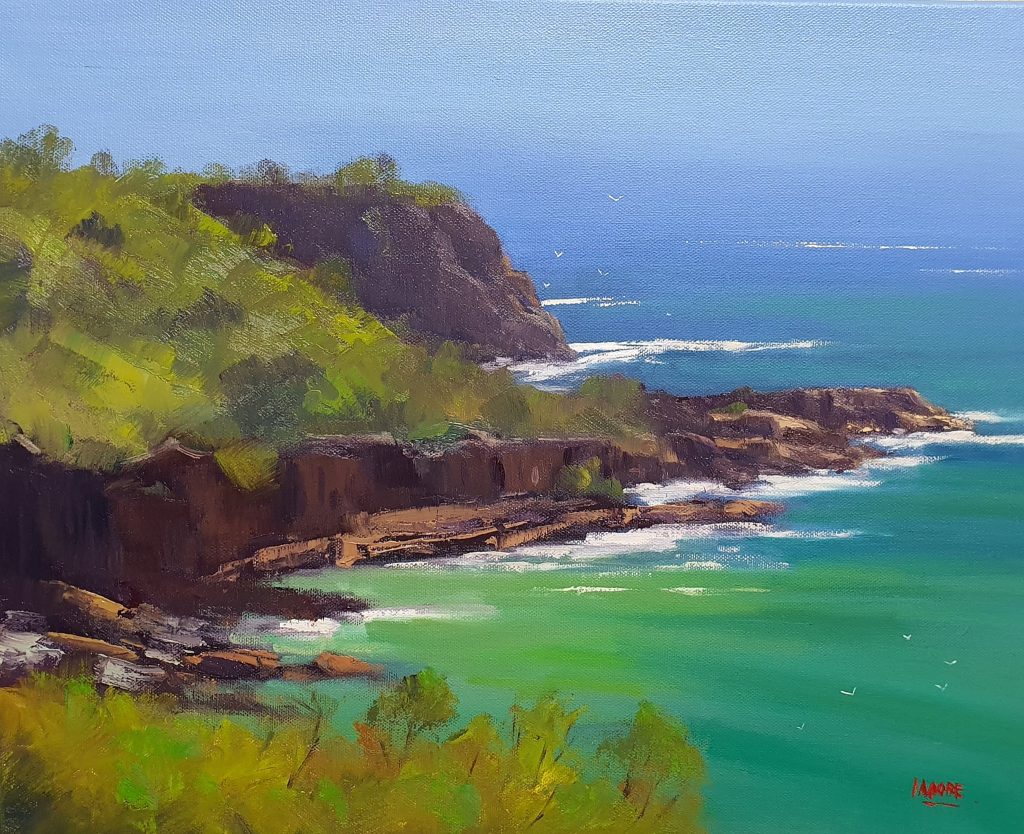
by Rod Moore
A Note About Paint Quality
As paint is the primary tool we work with to express ourselves with it is important you understand the differences in quality.
In simple terms there are two different qualities of paint.
The first is student quality, and the second is artist or professional quality. Within these two the quality of the paint can vary wildly as well.
Professional quality paint has a much higher pigment ratio, and contains less fillers, than student quality paint.
I strongly recommend you invest in artist, or professional, quality paints from the outset. Using a limited palette you only need a handfull of tubes of paint. Yes they will cost more per tube than the student grade will but it will save you years of frustation and fast track your results. Many beginners make the mistake of buying dozens of tubes of paints in a variety of colours. Because the cost adds up they gravitate to the cheaper student grade paints.
You are much better off with a handful of colours or a higher quality. It will cost you about the same dollars wise but will improve your painting from the start.
The colours we use in our simplified palette at the Learn to Paint Academy is:
- Ultramarine Blue – A semi transparent warm blue
- Alizarin Crimson – A semi transparent cool red
- Yellow Ochre – A warm yellow with an earthy tone
- Cadmium Yellow Light or Lemon Yellow – a lighter yellow for highlights
- Phtalo Green or Viridian – A strongly pigmented semi transparent green
- Titanium White
From these colours we can mix pretty much all of the colours we need for landscape, seascape, portrait, still life painting etc.
And if you do the maths you will find buying a limited range of colours like these in a professional grade of paint will work out no more expensive than buying twenty or thirty tubes of paint in a cheaper range. The results you achieve though once you learn to mix colours will be significantly better.
Where To Learn To Painting For Beginners
If you spend five minutes on the internet you will see that there is an endless range of options for painting for beginners information and education.
Just on YouTube alone you can loose yourself watching endless hours of videos from some of the best artists in the world down to complete amatuer artists. Its easy to go from one video to the next to the next and invest hours of time doing so.
Places like Facebook have groups and forums full of thousands of members all busy posting their photos of latest works, and giving and reciving feedback and advice to each other. There is an unlimited number of people out there willing to give detailed explanations on what they think of your painting and how you could improve it (even if they can barely paint themselves)
There are books, DVD’s, webinars, magazines, local art groups and on and on.
The problem with this abundance of resources available at your finger tips is that the average beginner to intermediate artist will spend a lot of time jumping from one instructor to another. From one apporach or method for creating a painting to another. From one subject matter to another. From one choice of palette to another.
This will slow your progress down dramatically.
When you bounce around all over the place you will retard your progress in painting. If you watch a video on landscape painting from a Bob Ross artist one day and try paint that style, and the next day you are trying to paint portraits in the style of Rembrandt … well you likely not improve much as an artist. At a minimum you will slow your progress down.
Many hobby artists never improve primarily for this reason.
Its a lack of focus. The problem is you need to focus in order to make steady progress towards your end goal.
So what should you do instead?
It’s my belief you should learn from a professional artist. It takes a good decade or more of moving through the four stages of learning towards mastery, to become a professional artist. So you can be confident that they have invested the time and energy to both learn the fundamentals and practise them.
Look for an artist whose work you like and admire. Check out their painting style and subject matter. Do you want to paint along similar lines? Does the work resonate with you?
That is the first step. Find a professional artist whose work you love and want to learn from.
The next consideration though is this … can they teach?
Not all professional artists can actually teach what they know. Many have no idea how to break complex concepts down into simplified easy to learn bite size pieces. Bite size pieces that you can take on board to actually improve your painting.
Note – There are many people online today who have set themselves up as Art Educators or teachers who have never even taught a physical art class with real live breathing humans in it. YouTube and Facebook are full of them. These people can not possibly understand what you need as a beginner to assist you in learning to paint. I can tell you from experience that unless you have taught a hundred or more art classes then you really have no idea of the challenges and obstacles beginners face when learning to paint.
To recap … you want to find a professional artist whose work you like and respect who also has a proven track record in teaching others to great success.
Now here is the real key.
When you find such an art teacher you want to totally immerse yourself in their work and learning everything you can from them. Go deep into their teachings. Do all their art classes, online courses, painting projects etc that you possibly can.
This is about focus as opposed to bouncing around all over the place. When you focus in with one teacher your work will start to improve at a much greater rate.
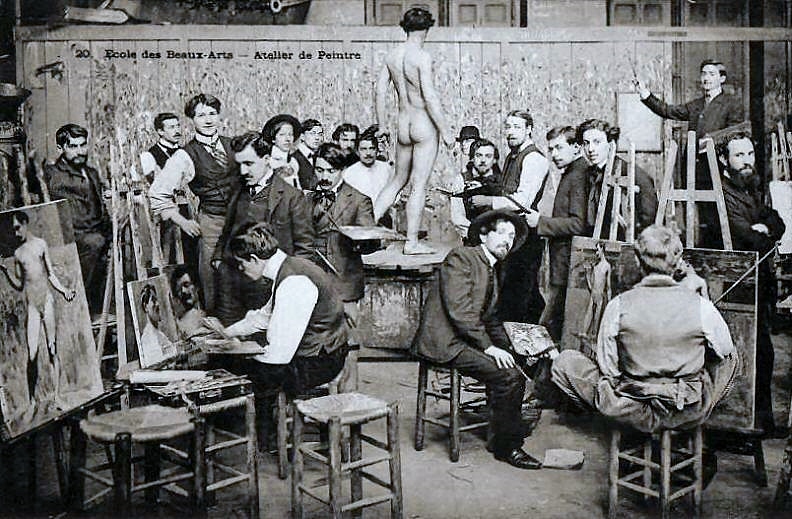
Sidenote – This is the way all of the great master artists of yesteryear learnt to paint. They would enroll in an Atelier in Europe under the tutelage of a master artist. They would study with them for four years every day. When they reached a point that they were ready to leave and take on the art world they had to paint a final piece of artwork for the Master Artist … known as a masterpiece. Only when the Master Artist who ran the Atelier was satisfied with the masterpiece could you graduate.
Equally important is to develop a focus on a medium such as oils or acrylics, and your subject matter when you are painting for beginners.
For example … it can take years to really get good at doing portraits so that you capture a likeness of the sitter. The same with landscape painting. It can take years to learn to create atmosphere and emotional intensity in a landscape.
If you try and jump from one subject to the next to the next you will slow down your rate of improvement.
Once you find a teacher you really want to learn from the next best thing to do is to choose a medium and subject matter. Focus in on developing a high level of skills with this medium and subject matter.
Learn everything you can about the chosen medium and subject matter. Focus over time is the key here.
Over the last ten years I have found a handfull of artists I personally follow. I have endeavoured to learn everything I can from them and its started to pay dividends. I have also focused in one medium, being water mixable oils, and landscapes as my primary subject.
I have no doubt that this focus has enabled me to move forward faster than if I had lacked focus.
Here are some of the most important keys I have learned in that time:
Keys To Learning Painting For Beginners
These keys to learning to paint are for those who are reasonably serious about developing their skills as an artist.
- Get clear on why you want to paint in the first place. Is it for a bit of fun, for therapy, relaxation, for social reasons, to earn an income, international fame and fortune? You get to choose and there is no right or wrong answer.
- Based on your why decide on what your end goal is for your painting journey. For me it was always to become a professional artist earning an above average income and bringing joy to the world through my painting. What is the end goal for you?
- Seek out a teacher whose work you admire and teaching style resonates with you. When you find them go all in and commit to doing all of their courses, workshops and painting projects that you possibly can.
- Choose a medium to learn to paint in. You can always change to another medium later on but for now choose one and decide to really master that medium. You may need to try out a few different mediums initially to settle on one but once you make the decision to focus on one medium spend some time focused on it.
- Choose a subject to specialize in. When you choose you want to focus on painting that subject until you really get a handle on it. There are different skills and knowledge you need for different subjects. For instance if you decide to paint portraits then you need to learn about the plains of the skull and how the different angles of these plains will change in different light sources. On the other hand if you choose to focus on landscapes then you need to study and master aerial perspective. Cityscapes would require a better understanding of linear perspective. So you can see your choice of subject will lead you to having to learn subject specific skills.
- Decide how much time you wish to commit to your painting journey each week. Learning to paint is a marathon not a sprint. You need to commit time to it and you need to stick with it for the long term. So allocate an amount of time each week to the study and practice of painting. The amount of time needed will be determined by your goals.
- Divide your weekly time allocation into study and acquisition of knowledge (via courses and workshops) and actual painting where you apply what you have just learned.
- Do a benchmark painting. This is a painting you do today that is the very best you can do. It becomes your benchmark which displays your current skills, knowledge, understanding of your medium and subject and so on. Keep this painting on your studio wall and aim to beat it. Do a benchmark painting annually and look for the improvement.
- Set up your studio space. You need a dedicated space to call your studio. This is where you can leave all of your supplies and equipment permanently set up. From experience and observation I have found that having a permanent set up makes it so much easier to get started painting. You don’t need a lot of room. My first studio was in a closet. As I achieved better results with my painting journey my studios got bigger.
- Keep a stock of art supplies. I have found that it is best to always have a supply of painting surfaces, brushes and paints on hand. There is nothing worse than getting half way through a painting when you are in the flow and you run out of Titanium White. You go to your local art supply store and they are sold out 🙁 Believe me this happens often. Better to order your art supplies online and always have extra tubes of the paints you use a lot of on hand.
- Shut out distractions. Tell your family, dog and attention seeking cat that your painting time is sacred and you can not have any distractions while you paint. Once you express how important your painting is to them they will hopefully respect your request.
- Remember the four stages of learning. It is inevitable that you will reach sticking points where you become frustrated. This is not the time to give up or assume you don’t have the talent for painting. During this time you need to develop patience and know that you can move through any sticking point and the associated frustration. All great artists at one time felt a sense of frustration with their progress or current work. Have faith you can move through it and just keep learning and painting.
- The more you learn the more you realise there is to learn. The great thing about painting and the journey towards mastery is that you can never know everything. In fact most of us will only ever acquire a fraction of the total knowledge base of master level painting. Even when you think you know something, like aerial perspective for example, there is often a lot more depth you can go into. And some things can only be truly learnt through practice. So always keep learning.
- Paint frequently. You are better to paint for twenty minutes a day each day for a month than to try and cram a months worth of painting into a weekend. Painting frequently has a dramatic impact on your skills. This is why the daily painting movement is so popular. If you can paint daily. If not then find the next most frequent schedule for your painting.
- Have patience. Painting takes time. A lot of time to truly master. If you have ambitions of becoming a professional for example then you need to think in terms of decades. I recently arrived at the ten year mark of my painting journey. While I have achieved a lot in that time I consider this first decade as my apprenticeship. The next decade will be where I really develop my skills towards mastery, and the third decade will be when I do my best work. Have patience my friend.
- 1,000 paintings. Master artist Kevin Macpherson suggests that in order to become a good artist you need to complete one thousand paintings. From experience I would agree with this and I wish I head heard this at the start of my journey. If you do a painting day over three years then you will significantly fast track your skills.
- Let your painting be your teacher. When we first start out we seek external validation for our paintings. We post in forums our latest work looking for feedback and likes. We seek the opinion of others on a similar journey. And mostly we are looking for advice on how to improve our paintings … but we are asking the wrong people generally. A better approach is to let your painting be your teacher. After completing each painting ask yourself what are two or things you did really well with this painting, and what is the one thing you need to focus on improving for the next one? Start a journal and post a photo of your painting with the answers to these questions in it. Do this for each painting you complete and watch how fast you develop. You will learn more from analyzing your painting and letting your painting be your teacher, than you will from getting feedback from others.
- Master the fundamentals. We talked about these earlier in this article. The fundamentals are things like composition & design, drawing, colour and colour mixing, values, edges, brushwork etc. Mastering these fundamentals is essential to developing great art.
- Immerse yourself in your subject matter. If you want to be a great landscape artist then you need to immerse yourself in the landscape. You can’t paint a subject you don’t know effectively as you miss the nuances of the scenes. As an example it would be difficult to become a great seascape artist if you have never been to the beach. A great seascape artist is typically someone who has a passion for the beach and is there all the time. When they go to paint it they are painting with salt in the hair and the sound of crashing waves fresh in their minds.
- Collect reference material. An essential part of an artists practice, yet rarely talked about, is constantly collecting reference material. You want to be collecting photos, doing sketches, small studies on location and other reference materials. Build up a library of your own reference materials. This ties back to immersing yourself in your subject. I am primarily a landscape artist and two to three times a year I am off on a road trip collecting reference material.
- Study master artists. Find half a dozen master artists whose work you love. Then find all of their paintings on the internet you can. Download them to your computer so you can really study there best works. Select half a dozen of your favorites works from your favorite artist and print them out and stick them in a journal. Then make notes about what you love in the painting, and what works well. What drew you to this piece of work? The more you study the masters before you the more you can form a vision of yourself moving to a master level.
- Visit Museums & Galleries. There is a big difference between looking at paintings online or in a book, versus standing in front of them in real life. When you stand in front of the works of the masters your experience is completely different as the heart and soul of the artist infuses the work with an energy you can feel. So visit museums ad galleries as much as possible and soak up the works of the greats.
- When painting switch off your conscious mind. Great painting is something that flows through you and bypasses your conscious thinking mind. It’s best if we can shut off our conscious mind when painting. Think less and feel more. If you have really studied the skills and gained the knowledge you need then it will move to your unconscious mind soon enough. How do you switch off your thinking mind? The easiest way is to play music while you paint or listen to your favorite podcast.
- Look for progress. Every three months compare your latest work against your last benchmark painting. Can you see obvious improvement?
- Be prolific. The great artists of history where all prolific. Picasso produced more than 40,000 pieces of artwork in his lifetime. The more work you produce the greater chance you have of producing some great work.
- It’s a mindset game. Really mastering anything in life is largely a mindset game. On some level you need to work on developing your mindset. This comes down to using your imagination to develop a vision of where you see yourself taking your art. And you need to develop a positive optimistic outlook. The more positive energy you develop the more positive things happen to you. Don’t ask me how that works but I can assure you it does. I can’t tell you how many negative artists I have met who have moaned about how great it was in the eighties to be an artist … and their careers have stalled or are non-existent. Things change, life moves in new directions and so we have to as well with a positive energy. If you think you can, and believe you can become a great artist you are far more likely to than if you have a real negative mindset.
- Don’t compare yourself to others. One of the worst mistakes you can make is comparing yourself to other artists. We are all on different journeys and we all come from different backgrounds and levels of competency. So never compare yourself to another artist. Just focus on you and developing yourself on your journey. It’s easier that way.
- Start selling your work as soon as you can. Use market places like eBay and Etsy to start to sell your work as soon as possible. Even if it is for low prices like $20 or $30 for your practice pieces. This way you get paid to learn to paint. And you can take the money you make and invest it back into more art supplies and more education. This is what I did early on and it accelerated my progress.
- Don’t wait for inspiration. Inspiration is largely a myth. As Picasso said inspiration does exist but when it shows up it better find you hard at work. Professional artists don’t work on inspiration … they just get to work and on a good day inspiration turns up as they work. They never use inspiration, or a lack of it, as reason for lack of production.
- Stay healthy. The healthier you are and the more energy you have the better you will paint. Trust me I have tried it both ways. At times during my painting journey I have been extremely unhealthy due to poor lifestyle choices. My painting and progress suffered. Today I am focused on improving my health and energy and my painting is improving in line with my health. It may seem unrelated but if you don’t feel well its hard to paint well.
- Have faith. When nothing seems to be going right with your painting and you are not happy with your production its easy to loose faith. For me I developed an understanding that there is a higher level of intelligence which is the source of all creativity. The more faith I developed in this the more I was able to tap into this infinite pool of creativity.
- Have fun. Perhaps the most important aspect of learning to paint and becoming a great artist is to have fun along the way. If you are miserable and generally unhappy its like trying to drive forward with the handbrake on. Painting should bring joy and happiness to you and the world. So have fun and spread fun.
These are just some of the keys to learning to paint that have been important to me in the last ten years. There are clearly a lot more keys I can share with you and will do so in a follow up article in the future.
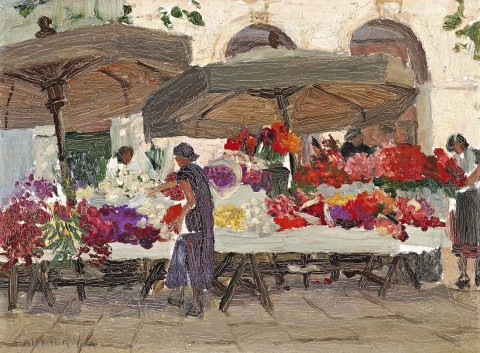
by Ethel Carrick Fox
For now though take on board these keys and I assure you that you will make progress faster and enjoy the journey more.
Let me know how you go.
In the comments share with us your reason why you want to paint and what you see as being your end goal with painting.
To learn more about the Learn To Paint Academy and how you can get access to 35+ full length painting courses and 150+ painting projects – Click Here For Details


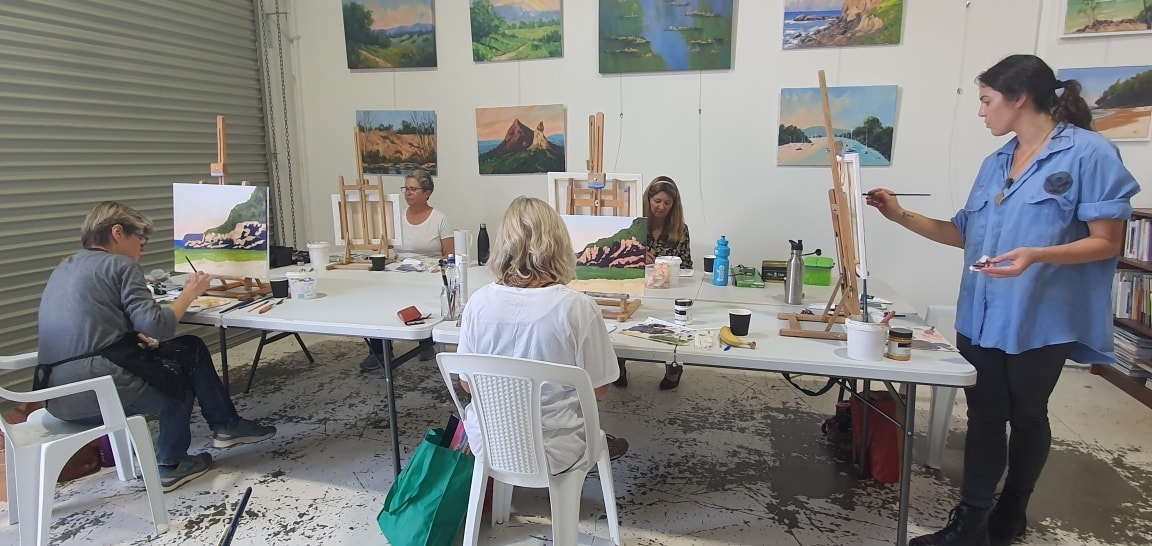
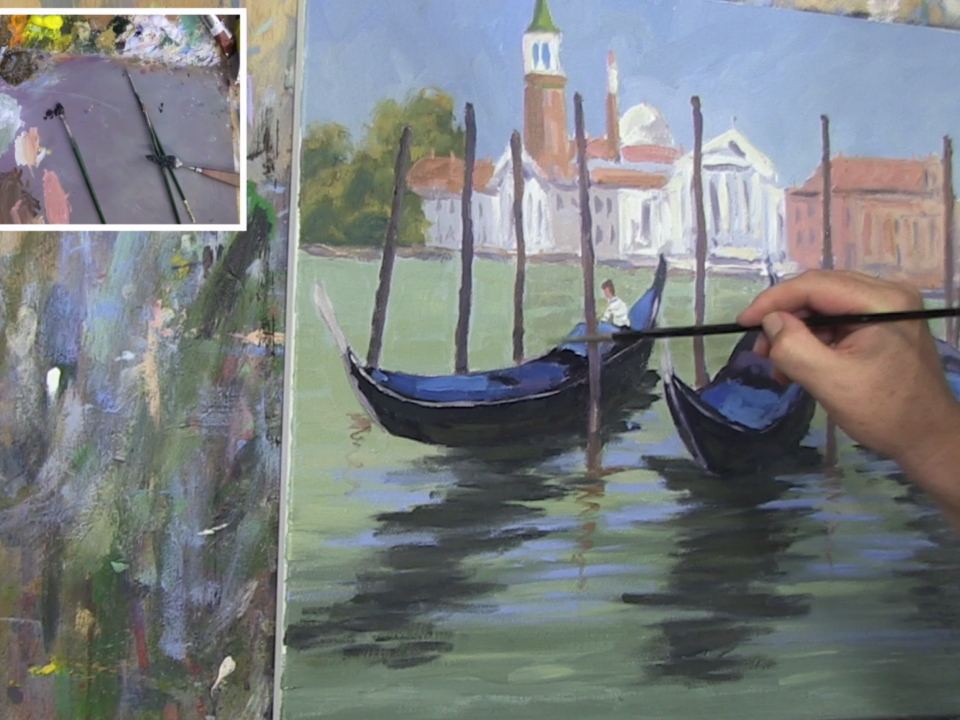
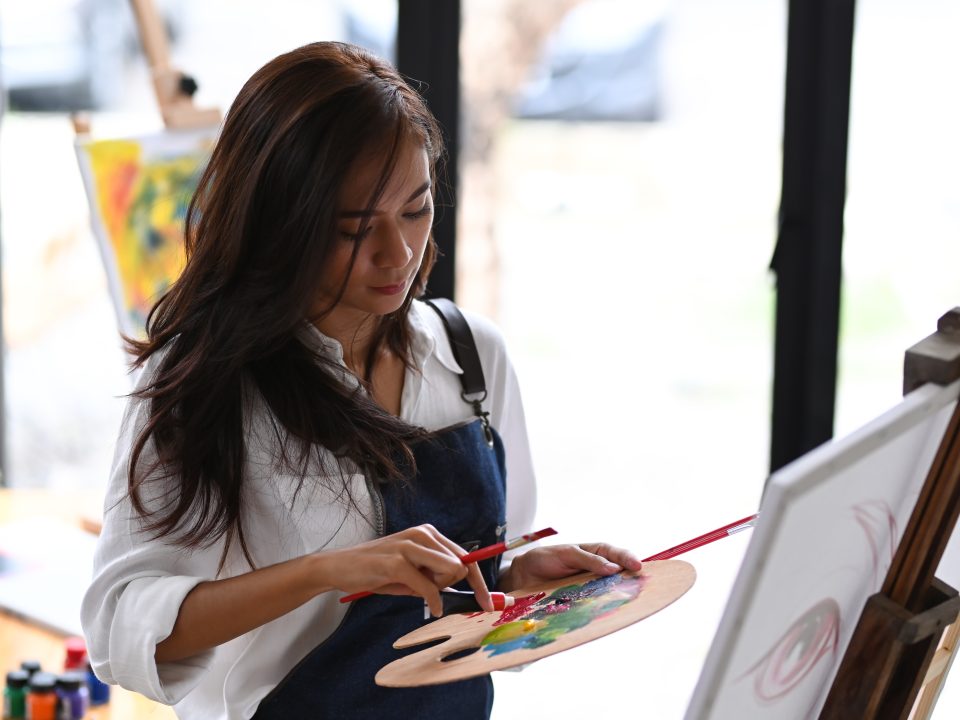
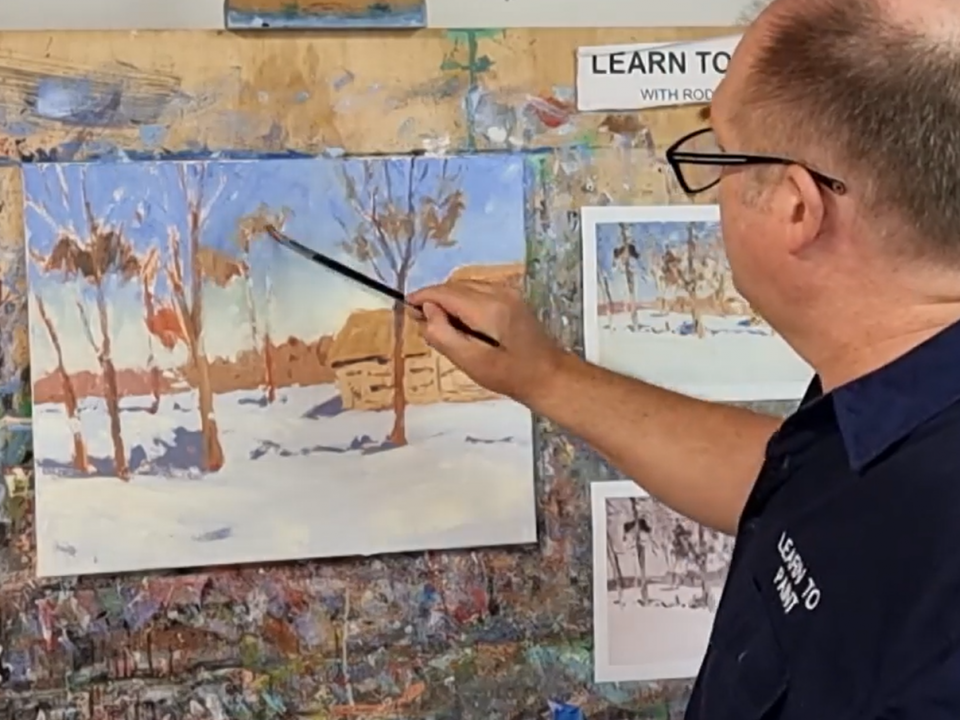
Some really great tips and info. Your passion for painting is obvious. Your willingness to share your knowledge is so refreshing. Thanks
Glad you found it helpful Shelly. Thanks for reading
Can truly relate to everything in your blog ! I’m a lifetime member and need to make some serious decisions as to the direction I want to take. I’m a member of an art club and have been watering down my focus with experimenting with different mediums and feel that technically I’m not moving forward as I would like. Looking forward to your next blog .
Thanks for reading Carla and I’m glad this blog post resonated with you. Yes its easy to be not focused and sometimes we need to do that to try all the options etc. To start making solid and consistent progress though it helps to start developing some focus.
I enjoyed the video and the commentary very much Rod. Very inspiring and thank you for it!
Glad you enjoyed it Mary. Thanks for reading
I have just become a life member, although I have always loved painting and have been taking classes for several years I find Rods very clear, simple instructions on the basic concepts very helpful and feel I have improved already in just the few instructive demonstrations I have watched. Quite thrilling.
That’s great to hear Rachel and thanks for becoming a life member. It’s always exciting when you can see real improvement in your work.
I joined up about 4mths ago and honestly felt a little cheated as never quite felt the right fit for me – but with this latest addition I have just read I feel re- energised and the upgrading of your website has been great for me personally – thank you
Sorry to hear you didn’t feel it was a good fit for you Margaret. We are constantly working on improving the member experience and our teaching to help our students improve their painting
I now find I can do plein air painting following the Rod Moore method, I have always shied away from it as the scenes seemed to be too busy, now by simplifying the scene into 5 sections I have succeeded and am very happy with the final result. Thankyou Rod.
That’s terrific to hear Stephanie … well done 🙂
great article, look forward to learning more.
Thanks for stopping by to read it Paula
You used to offer other courses–are they all gone?
Hi Judith … we have 35+ courses and 150+ projects … they are accessible via the membership options at http://LearnToPaint.academy/join
Hello Rod
Happy and safe New Year to you and yours from Dingle
I was looking forward to meeting you in Provence last summer as you were going to be near us there but it was not meant to be! C’est la vie! Soon hopefully
just read your blog and feel energized again. Thank you.
Anne
Thanks Anne … Happy New Year to you to. Yes would have been great to meet up but I suspect it may be some years before the opportunity presents again. Hope your art classes are going well
Thanks Rod for this. I have been painting for many, many years but I have still found help and inspiration in what you have put out there for all of us struggling through a difficult time with our painting. Since joining up in the Free Course in November I have completed some paintings that I am proud of and have taken out my supply of paintings and did some improvements on them! I would definitely recommend your course, not just for beginners but up to the Master painting!!
Rod, I have been a free member since last Nov. I wished to sign up for the special course $69.00 Fundamentals Course. When I changed my profile, I also tried to change my password unsuccessfully and now it won’t accept me because now I have no password! At the same time I tried to pay for the course and was rejected. I thought that might be because I used a different Visa card (my husband’s) and I could not charge because your accounts would not accept it. Could you please help me with this problem. I know this is not the place for this but you won’t let me in!! I also would like to say that I really enjoyed the free course. It took me back to basics and I think I really needed that. I also think it is great having the Groups so we can share our trial and tribulations along with our joy in painting! Whoops that belongs to another show I believe. Anyway, any help u can give me would be appreciated….MarymFell